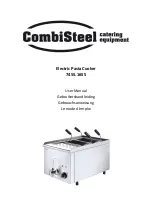
24
Refrigeration system
Condenser unit operation
The condensing unit is weatherproof and equipped to operate in ambient temperatures from – 2 0˚F – 120˚F
(– 29˚C – 48.9˚C). The condensing unit is controlled by a dual pressure control which works in concert with
a refrigerant solenoid valve on the evaporator module. On start-up, the refrigerant solenoid valve opens and
suction pressure rises above the “on” set point of the control (30 psi). The compressor and fan turn on and the
refrigeration system operates. Upon shut down, the refrigerant solenoid closes. The compressor will pump down
the suction line until the low “off” set point is reached (10 psi), at which point the compressor and fan will turn off.
Low ambient operation: Reliable operation at low ambient temperature is achieved with a pumpdown cycle, a
crankcase heater and a head pressure control valve. As the ambient temperature falls and the head pressure
decreases the valve maintains a minimum head pressure of 180 psi by bypassing discharge gas around the
condenser to the receiver to increase the pressure at the condenser outlet. This backs liquid refrigerant up in the
condenser to reduce the area available for condensing which increases the head pressure to maintain the 180
psi set point. A check valve is installed in the liquid line between the receiver and the condenser to prevent liquid
migration from the receiver to the condenser during the off cycle. The crankcase heater works in conjunction with
a continuous pumpdown cycle to prevent accumulation of liquid refrigerant in the compressor oil during the off
cycle. This prevents compressor damage due to a flooded compressor start. The low pressure control will start
the condensing unit anytime the low side pressure rises above the 30 psi set point and pump the refrigerant
out until the pressure falls to 10 psi. The crankcase heater, which is energized whenever the condensing unit
has power, keeps the compressor oil warmer than the coldest location in the system. This minimizes off cycle
refrigerant migration. If power to the condensing unit is interrupted after the system is charged the compressor
should not be started unless the crankcase heater has been energized for at least four hours immediately prior
to compressor startup. However the compressor can safely be started during the refrigeration system charging
process (without the warm-up period) once sufficient refrigerant is in the system to maintain a positive pressure
on the suction side of the compressor.
Air-cooled condensers (air)
60˚F/16˚C 70˚F/21˚C
80˚F/27˚C
90˚F/32˚C 100˚F/38˚C
Pressure (psig)
discharge/suction
220/24 225/25 236/25 247/27 250/28
Refrigerant pressure data
R404A icemaker charge specifications
Model
Line Run
Charge
1400
0 – 50 ft (0 – 15.2m)
11 lbs (4.9kg)
50 – 75 ft (15.2 – 22.9m)
12 lbs (5.4kg)
75 – 100 ft (22.9 – 30.5m)
13 lbs (5.9kg)
100 ft+ (30.5m+)
Consult factory
Refrigerant charges
















































